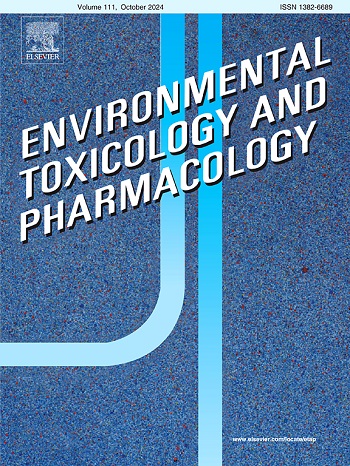Association of volatile organic compound exposure and metabolic syndrome
IF 4.2
3区 环境科学与生态学
Q2 ENVIRONMENTAL SCIENCES
引用次数: 0
Abstract
The cumulative toxicity of volatile organic compounds (VOCs) cause many medical diseases. We analyzed the evidence of association between VOCs and risk of metabolic syndrome in the Korean population using 1771 participants from the 2023 National Health and Nutrition Examination Survey. The creatinine-corrected urinary concentrations of BMA, 2-MHA, PGA, SPMA, 3-HPMA, BPMA and DHBMA were higher in the metabolic syndrome group than in the non-metabolic syndrome group. Urine N-Acetyl-S-(phenyl)-L-cysteine (SPMA) levels were significantly associated with metabolic syndrome after adjusting for confounders (odds ratio: 1.71). 2-MHA (OR 1.29, P=0.035) and SPMA (OR 2.84, P<0.001) were associated with the risk of elevated FBG impairment and SPMA (OR 1.57) was positively connected with the high blood pressure (P=0.016). In conclusion, the findings indicated significant association between the metabolic syndrome and a number of VOCs. Among them, there was a substantial positive correlation between the urinary SPMA levels and metabolic syndrome.
挥发性有机化合物暴露与代谢综合征的关系。
挥发性有机化合物(VOC)的累积毒性会引发多种疾病。我们利用 2023 年全国健康与营养调查的 1,771 名参与者,分析了韩国人群中挥发性有机化合物与代谢综合征风险之间的关联证据。代谢综合征组的 BMA、2-MHA、PGA、SPMA、3-HPMA、BPMA 和 DHBMA 的肌酐校正尿浓度高于非代谢综合征组。尿液中的 N-乙酰基-S-(苯基)-L-半胱氨酸(SPMA)水平在调整了混杂因素后与代谢综合征显著相关(几率比:1.71)。2-MHA(OR1.29,P=0.035)和 SPMA(OR2.84,P=0.035)与代谢综合征密切相关。
本文章由计算机程序翻译,如有差异,请以英文原文为准。
求助全文
约1分钟内获得全文
求助全文
来源期刊
CiteScore
7.00
自引率
4.70%
发文量
185
审稿时长
34 days
期刊介绍:
Environmental Toxicology and Pharmacology publishes the results of studies concerning toxic and pharmacological effects of (human and veterinary) drugs and of environmental contaminants in animals and man.
Areas of special interest are: molecular mechanisms of toxicity, biotransformation and toxicokinetics (including toxicokinetic modelling), molecular, biochemical and physiological mechanisms explaining differences in sensitivity between species and individuals, the characterisation of pathophysiological models and mechanisms involved in the development of effects and the identification of biological markers that can be used to study exposure and effects in man and animals.
In addition to full length papers, short communications, full-length reviews and mini-reviews, Environmental Toxicology and Pharmacology will publish in depth assessments of special problem areas. The latter publications may exceed the length of a full length paper three to fourfold. A basic requirement is that the assessments are made under the auspices of international groups of leading experts in the fields concerned. The information examined may either consist of data that were already published, or of new data that were obtained within the framework of collaborative research programmes. Provision is also made for the acceptance of minireviews on (classes of) compounds, toxicities or mechanisms, debating recent advances in rapidly developing fields that fall within the scope of the journal.

 求助内容:
求助内容: 应助结果提醒方式:
应助结果提醒方式:


